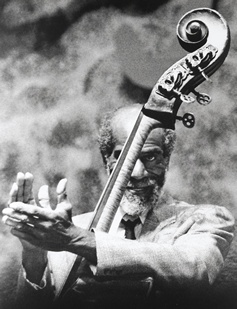John Heard
 A very talented bassist, John Heard has appeared in a countless number of musical situations through the years, always distinguishing himself.
A very talented bassist, John Heard has appeared in a countless number of musical situations through the years, always distinguishing himself.
He started out playing saxophone but switched to bass before joining the Air Force in 1958. After his discharge, Heard worked in Pittsburgh, spent time living in San Francisco (1966-68) playing with Al Jarreau, and primarily freelanced in New York and Los Angeles. Among his many musical associations have been Booker Ervin, Wes Montgomery, Sonny Rollins, Randy Weston, Ahmad Jamal (1972-77), the Count Basie Orchestra (1974-76), Toshiko Akiyoshi, Louie Bellson, the Oscar Peterson Trio, Joe Williams, Barney Kessel, Eddie “Lockjaw” Davis plus many others. Because he is a skilled artist, there have been times when it appeared that John Heard would retire from music, but his absences have been fortunately quite brief. His one date as a leader took place in 1983 for the tiny Los Angeles-based ITJ label
He first attracted serious attention in the early and mid-60s, working with artists such as Tommy Turrentine and Al Jarreau. Towards the end of the decade he was with Sonny Rollins, then settled on the west coast where he became a long-serving member of several bands, including the Ahmad Jamal trio, Count Basie’s big band and small recording groups, and Toshiko Akiyoshi’s group. He was also first call bass player for the big bands occasionally assembled by Louie Bellson, with whom he visited the UK in the late 70s and early 80s. He then spent time with Oscar Peterson, Cal Tjader, George Duke, Joe Williams, Nancy Wilson, Tal Farlow and many other leading singers and jazz musicians. The quality of the company he keeps is eloquent testimony to Heard’s considerable skills. Whether playing in a big band, where his powerful pulse urges along the ensemble, or subtly providing accompaniment to pianists, guitarists or singers, Heard has established an enviable reputation amongst his peers in the jazz world, although he remains relatively little known to audiences.
A few of the artists John Heard has played with include: Ahmad Jamal, Airto Moreira, Art Pepper, B.B. King, Benny Carter, Bobby Hutcherson, Bud Shank, Cal Tjader, Clark Terry, Count Basie, Eddie “Cleanhead” Vinson, Eddie “Lockjaw” Davis, Ella Fitzgerald, Frank Morgan, Gary Foster, Gene Harris, George Cables, George Duke, Harold Land, Harry “Sweets” Edison, Ira Sullivan, Jack Wilson, Jean-Luc Ponty, Joe Henderson, Joe Williams, John Haley Sims, Kenny Burrell, Larry Vuckovich, Lester Chambers, Lew Tab ackin, Lionel Hampton, Loren Pickford, Lou Levy, Louie Bellson, Madeline Vergari, Mick Taylor, Mike Campbell, Moacir Santos, Ned Doheny, Nick Brignola, Oscar Peterson, Paul Moer, Pharoah Sanders, Ramblin’ Jack Elliott, Richard Boone, Roger Neumann, Ross Tompkins, Roy McCurdy, Tete Montoliu, Toshiko Akiyoshi, Zoot Sims, and too many more to mention…




